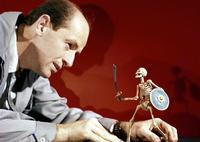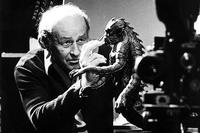A true legend of the silver screen passed away earlier this week, and while you may not know his name or what he looks like, chances are if you've ever watched a science fiction, fantasy, or action-adventure film and been amazed at the special fx or blurted out "HOW did they do that?!", you can trace it all back to Ray Harryhausen.
Much like the fans his amazing and groundbreaking work would later thrill and inspire, Harryhausen himself was a mesmerized moviegoer after a screening of King Kong in 1933; one of the first films to use the "stop-motion animation" technique, where a physical object is moved in small increments between individually photographed frames, creating the illusion of movement when the film is screened together as a whole.
Harryhausen would go on to be a pioneer in the visual effects world of films, a one man special fx department whose precision and dedication to his craft was legendary as noted by this entry in his bio from IMDb: "The most famous example of the kind of patience required being the exciting skeleton sword fight sequence in Jason and the Argonauts (1963) in which Harryhausen often shot no more than 13 frames of film (one-half second of elapsed time) per day." A far cry from the speed and ease of CGI effects and computers nowadays!
Filmmakers such as Steven Speilberg, George Lucas, Peter Jackson, and Tim Burton have all cited Ray Harryhausen as a tremendous influence and you only have to look at Raiders of the Lost Ark, Star Wars, Lord of the Rings or The Nightmare Before Christmas to prove it.
The video below brings back fond childhood memories of lazy weekend afternoons, sprawled out on the floor of the living room watching Jason and the Argonauts, The Beast from 20,000 Fathoms (1953), The 7th Voyage of Sinbad (1958), or Clash of the Titans (1981) with my brother on now bygone UHF channels like Ch. 48 and Ch. 57.
Learn more about Ray Harryhausen and check out his films at the Free Library!
Have a question for Free Library staff? Please submit it to our Ask a Librarian page and receive a response within two business days.



